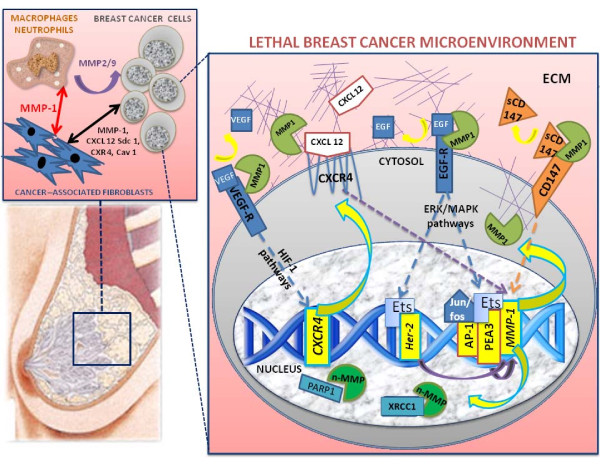Figure 2.
Schematic view of the role and functions of MMP-1 in breast cancer microenvironment. The breast microenvironment is composed of ductal and luminal epithelial cells sitting on a layer of myoepithelial cells, and stromal cells (including leukocytes, fibroblasts, and endothelial cells). The microenvironment alterations during breast cancer (BC) progression lead to a decrease of myoepithelial cells, phenotypically altered because of signals coming from the tumor and stromal cells. The cell-cell and cell-matrix interactions during BC initiation/progression involve the interplay among cancer-associated fibroblasts, macrophages and BC cells. The secretion of MMP-1 and the release of soluble proteins (including EGF, VEGF, CD147, syndecan-1) in the breast milieuare able to activate tumor pathways, generating the 'lethal BC microenvironment', which triggers a 'vicious cycle' between tumor and stromal cells, enhancing the BC growth, and promoting the invasive and metastatic processes via paracrine interactions [13]. The unexpected roles of MMP-1 interstitial collagenase are related to the proteolytic activity in the ECM compartment and the cell-cell interactions. The unexpected nuclear localization of some MMPs has been recently linked to new functional roles of these proteases within nuclei of tumor cells, with the ability to cleave peculiar nuclear peptides (Mannello et al, ms in preparation). The proteolytic activity of MMP-1 in BC cells is linked to the cleavage/release of soluble VEGF, EGF, CXCL 12 and CD147 from their receptor complexes. These proteins are able to activate crucial cancer metabolic routes (like HIF-1-dependent and MAPK and ERK-dependent pathways) that promote BC proliferation, triggering a vicious cycle through the molecular activation of some transcription factors (like AP-1, PEA3 and Ets), indispensable switches for the HER-2, CXCR4 and MMP-1 gene regulation [39]. The secretion of MMP-1 is also able to activate other MMPs (like MMP-2 and -9) which have been widely recognized as crucial steps for the BC evolution [14].

